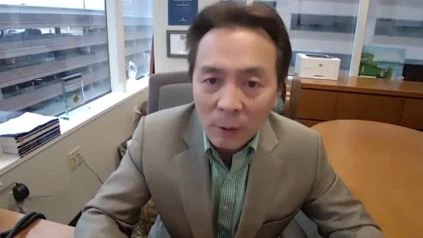Michael Wang, MD, ZUMA-2 Lead Investigator, and Professor at The University of Texas MD Anderson Cancer Center speaks to us about Management of a patient with mantle cell lymphoma who developed severe neurotoxicity after chimeric antigen receptor T-cell therapy in ZUMA-2.
AbstractÂ
Cerebral edema following T-cell therapy with chimeric antigen receptor (CAR) can be fatal. In relapsed / refractory mantle cell lymphoma, ZUMA-2 is a pivotal phase 2, multicenter trial testing KTE-X19, an autologous anti-CD19 CAR T-cell therapy. A 65-year-old ZUMA-2 patient who developed cerebral edema following CAR T-cell therapy and had complete recovery after clinical multimodality intervention including rabbit antithymocyte globulin (ATG) has been identified. Early and robust CAR T-cell expansion and associated activation of inflammatory cytokines are shown by biomarker findings, accompanied by rapid declines in CAR T-cell and proinflammatory cytokine levels after administration of ATG. This clinical profile underlines the possible importance of ATG in the treatment of serious neurotoxicity linked to CAR T cells.
Context
In relapsed / refractory B-cell malignancies, chimeric antigen receptor (CAR) T-cell therapies targeting CD19 have shown impressive efficacy. However, with CAR T-cell therapy, neurological events (NE) are severe toxicities frequently encountered and remain a therapeutic obstacle. Although low-grade NE is normally reversible, grade 4 NE can be fatal and is commonly associated with cytokine release syndrome (CRS), increased permeability of the blood-brain barrier, endothelial activation, and poor survival. Disease recovery and treatment-related toxicity are associated with CAR T-cell expansion and associated increases in cytokine/chemokine levels. However, the early and rapid expansion of CAR T cells and associated development of cytokines, including cerebral edema, have also been correlated with extreme NE.
In patients with relapsed / refractory mantle cell lymphoma (MCL), ZUMA-2 is a phase 2, multicenter trial testing KTE-X19, an autologous anti-CD19 CAR T-cell therapy. KTE-X19 uses a manufacturing procedure that extracts CD19-expressing circulating cells for use in leukemic and MCL indications. Clinical management of a ZUMA-2 patient who developed grade 4 NE with cerebral edema that resolved after multimodal clinical intervention treatment including rabbit antithymocyte globulin (ATG), an immunosuppressant that in vivo depletes T lymphocytes, is presented.
Methodology
Patients in ZUMA-2 had relapsed / refractory MCL with one to five prior therapies, as previously stated. Prior treatment could include chemotherapy containing anthracycline or bendamustine, an anti-CD20 monoclonal antibody, and an inhibitor of Bruton tyrosine kinase (ibrutinib or acalabrutinib). One regimen was counted as induction plus consolidation/maintenance and/or all treatments that occur between sequential complete responses. Written, informed consent was given by all patients and the procedure was accepted at each site by the Institutional Review Board. In accordance with the principles of the Declaration of Helsinki, the ZUMA-2 analysis was conducted. The trial was registered with the List of ClinicalTrials.gov; NCT02601313.
As previously reported, patients underwent leukapheresis with optional bridging therapy accompanied by conditioning chemotherapy (cyclophosphamide 500 mg / m2 / day; fludarabine 30 mg / m2 / day) on days 5 to 3.4 KTE-X19 was injected at a target dose of 2 to 106 CAR T cells/kg on day 0.4 CRS per Lee et al.15 National Cancer Institute Common Terminology Criterion for Adverse Events, V.4.03, was used at a target dose of 2 to 106 CAR T cells/kg on day 0.4. Serum collected at baseline and on days 0 (postconditioning and prior to KTE-X19) and on days 3, 7, 14, and 28, using previously reported methods, was assessed for 44 cytokines, chemokines, circulating angiogenic factors, immune effector molecules, and macrophage activating syndrome markers. For the identification of T and myeloid lineage cells, a trained flow cytometry assay was carried out on immune cells isolated from cerebrospinal fluid ( CSF) and other normal immune markers. From central laboratory assessments, all measurements mentioned above were derived. Although the patient was enrolled in ZUMA-2 for comparison with the wider ZUMA-2 population in this study, this patient was excluded from the ZUMA-2 cohort medians and evaluations listed herein.
Outcomes
Report of the event
A 65-year-old man with relapsed / refractory pleomorphic MCL (ibrutinib-refractory; supplementary online methods) in stage IV has been enrolled. No history of prior neurological disorder has been reported. Prior to KTE-X19 infusion, the patient had a performance status score of 0, non-bulky disease, a Ki-67 proliferation index of 80 percent-90 percent, and 410 IU / L baseline lactate dehydrogenase levels in the Eastern Cooperative Oncology Community. There was an unremarkable initial brain MRI (online supplementary figure S1). The patient administered conditioning chemotherapy followed by KTE-X19 infusion following leukapheresis. Prophylactic levetiracetam was initiated prior to the infusion and there was no sign of fever or infection. The serum levels of cytokines measured before and after lymphodepletion were close to those in other ZUMA-2 patients. The product properties of KTE-X19 were also equivalent to those of other patients. A timeline of clinical activities, including imaging tests and treatments, is represented in Figure 1. The level of evidence behind the interventions used is given by the online supplementary table S1. Serum levels of cytokines and blood levels of CSF and CAR T cells.

